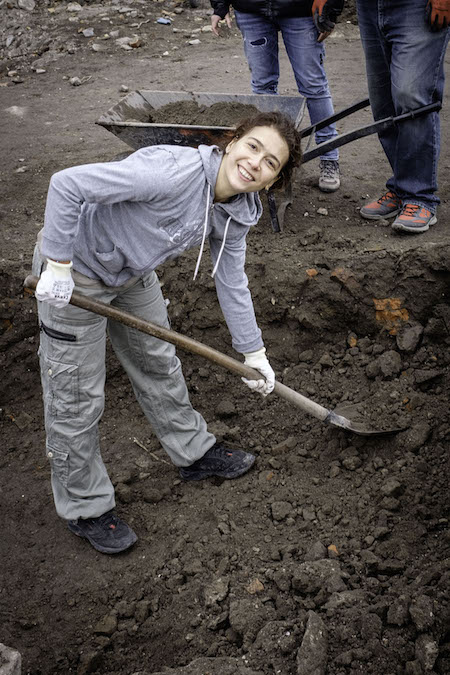
By Dimana Trankova
Dimana Trankova is an archaeologist by education and a journalist by vocation. She joined Vagabond Media in 2006 and is currently an editor at Vagabond, Bulgaria’s English-language magazine, where she writes about travel and local culture in Bulgaria, the Balkans, and beyond. She is a coauthor of a series of non-fiction books and guidebooks on the historical, archaeological, and cultural heritage of Bulgaria in English and Bulgarian, and the author of the novels The Smile of the Dog (2014) and The Empty Cave (2017).
The Bishop’s Basilica of Philippopolis came back to life thanks in part to her skillful penmanship.
“Is this the Bishop’s Basilica?!” In 2013, the view was uninspiring. At the time, the America for Bulgaria Foundation was helping with the conservation and socialization of the early Christian Small Basilica and its intriguing mosaics. The team of Vagabond magazine was commissioned to create the information materials: display signs, brochure, website (www.romanplovdiv.org). Our goal was to offer an intelligent, accessible account of the Small Basilica and the city in which it was located—Roman Philippopolis—as well as its people, gods, temples, and stories.
The Bishop’s Basilica was a part of this story.
You can imagine my disappointment when we saw a decrepit metal fence on Maria Louisa Boulevard. Weeds peeked through the gaps. As an archaeology graduate, I am aware that an important archaeological site doesn’t always make for an exciting viewing experience. But the sight of the overgrown basilica right in the center of Plovdiv shocked me. Then I reminded myself that this was how things were usually done in Bulgaria: you excavate a site and then you leave it to the elements.

“Is this the Bishop’s Basilica?!” In the fall of 2016, I was standing amid the excavated ruins that replaced the weeds. Shovel in hand, I felt like a child in a candy store. The Foundation had decided to support the comprehensive study and socialization of the Bishop’s Basilica, and almost every weekend it organized volunteers to help the archaeologists with the rougher work. Of course I got involved. I don’t work as an archaeologist, but I miss taking part in excavations.
I was taken aback by what I saw. It is one thing to know that the Bishop’s Basilica is one of the largest early Christian temples in the Balkans. It is quite another to find yourself among its ruins, between fallen columns, medieval skeletons, and magnificent mosaics peeking out from under the dirt. Curious passersby lingered at the nice temporary fence above, in front of the St. Ludwig Roman Catholic Cathedral; they watched the excavations, they were excited. And I was on site. I inhaled the scent of freshly turned soil. And I was holding a shovel!
My muscles ached the next day. Afterward, the Vagabond team returned to the site several more times—and we brought friends.
“Is this the Bishop’s Basilica?!” In 2018, Vagabond joined the organizational machine responsible for establishing the Basilica visitor center. Again, we had to convey the exciting story of an early Christian temple and of Roman Philippopolis through intelligent, yet accessible storytelling.
The scale was different now. The Bishop’s Basilica wasn’t just bigger and with more mosaics. Its history was richer: it included an ancient temple dedicated to the deified Roman emperor, a center of an early Christian community, a residential neighborhood, a medieval necropolis with a richly decorated church. Century after century, the layers of time and oblivion left their marks on the place.
Now, right before my eyes, archaeologists, epigraphers, numismatists, mosaic restorers, and forensic anthropologists were restoring the complex picture of the past. As the archaeological research advanced, the restorers collected every piece of mosaic, and the architects created concepts for the future visitor center, I grappled with a growing number of questions that I had to answer and explain in an easy-to-understand language for future visitors—Bulgarians as well as foreigners. Why was such a large church built in the center of Philippopolis? Why were so many peacocks depicted on its floor? What did an early Christian mass look like, and why is it important to understand it if we want to unravel the mysteries of the Basilica? Who were the people who worshiped in the cult of the Roman emperor? And the people buried in the medieval necropolis? How many centuries does the history of this place go back? How are mosaics made? Where did the colorful stones to create them come from? Why was the Basilica abandoned? Why did people build houses in its ruins? Why was it forgotten?
I read academic books and articles, badgered the archaeologists and restorers with questions, and got exasperated when the copy didn’t come out understandable or informative enough. I wrote, rewrote, then started all over again. This is what happens when the task is enormous, and a large international team is involved.

“Is this the Bishop’s Basilica?!” A few days ago, I entered the completed visitor center for the first time. I passed through the atrium, stopping at the inscription with the names of Roman citizens from the institution that managed the imperial cult in Philippopolis. I continued past the gorgeous peacock in the narthex, entered the mosaic-making workshop, and went up to see the bird mosaics on the second floor.
I lingered at the reader rail talking about the Basilica’s study. Yes, this is what it looked like eight years ago—a ruin overrun by weeds and hidden behind a rickety metal fence. I am happy to have been a small part of its transformation—with the texts I wrote, the stories I learned, and the friends I made. Shovel in hand.

